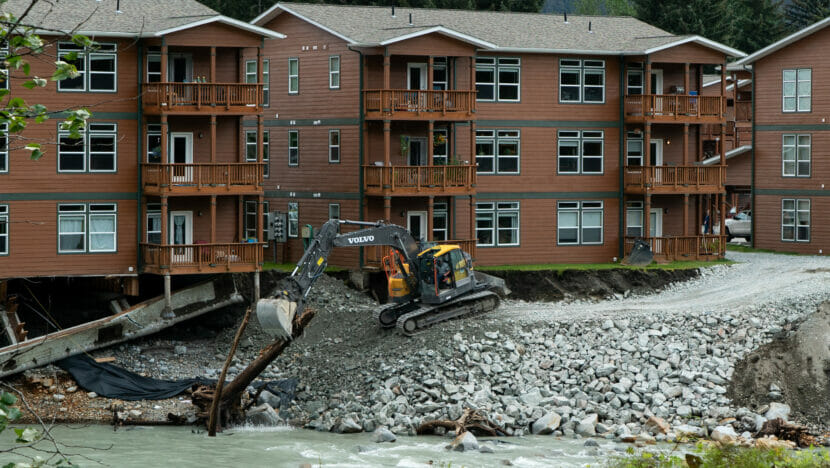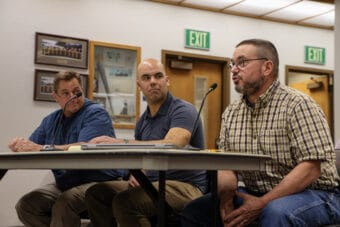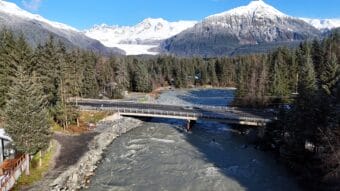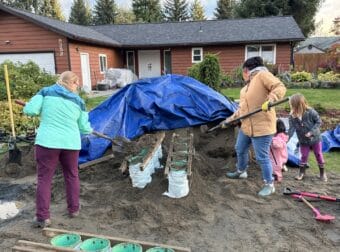
Juneau’s record-breaking glacial outburst flood in August nearly sent a condo building on Riverside Drive into the Mendenhall River.
The morning after the disaster, Riverside Condominium Homeowners Association treasurer John Dittrich saw the building hanging over the edge of the riverbank. He called a meeting of the HOA board.
“It seemed very precarious, where it was sitting. So we acted immediately,” Dittrich said. “We authorized emergency use of our reserves. Which were never intended for something like this.”
Money collected from residents for routine maintenance like trash pickup or the occasional paint job became a disaster relief fund instead. There was enough money to stabilize the precarious Building D, but that was just a fraction of the necessary repair work. Building D needs a new foundation, and the erosion left three more buildings vulnerable to future floods.
The cost to fix those things is estimated at more than $1 million.
The state disaster declaration freed up some recovery money — up to $20,500 per homeowner. But the way Alaska law treats HOAs — and the way state disaster aid is doled out — makes the Riverside Condo residents ineligible for state aid.
“You’re stuck paying, but you can’t put your hat out for some more money,” Dittrich said. “So it’s frustrating for a lot of people.”
Recovery aid falls short
Condo residents say recovery aid from familiar safety nets like insurance and federal and state disaster aid has fallen short of their expectations. In the weeks since the flood, insurance has denied most of their claims. Then, in late September, the Federal Emergency Management Agency denied requests for disaster aid.
Brenna Heintz still hasn’t been able to get into her unit on the top floor of Building D. She applied for individual disaster assistance from the state, which can hypothetically cover repairs for property that’s damaged in a natural disaster. But she was denied.
The state told her that repairs for her damaged building were not her responsibility.
“It’s the HOAs responsibility. But in order for them to fix that they need money, and that comes from us,” Heintz said. “I am not eligible for homeowners aid, even though the money is coming out of my pocket.”
That’s because Alaska state law requires that homeowner’s associations share responsibility for “common elements.” In this case, all of the Riverside Condo buildings count as a common element, and all 51 homeowners in nine HOA condo buildings are on the hook for repair costs, even though most of the buildings were untouched by the flood.
Each individual condo owner will have to pay between $21,000 and $26,000 for the repair work, depending on the size of their unit. But under those same state laws, the HOA is treated like a nonprofit business, not a group of individuals. Which means people like Heintz can’t access most forms of individual state disaster aid.
“I was naive about the scope of this when it first happened. And I was naive about the actual amount of money it would take,” Heitz said.
Donations, private loans fill the funding gap
Heintz and some of her neighbors are relying on donations from family, friends and the community at large. One of Heintz’s friends set up a GoFundMe that raised almost $28,000 — just enough money to cover Heintz’s share of repairs.
She said that without those donations, she’d have to take out a loan. And that’s what many residents in the undamaged buildings are doing. A local lender, True North Federal Credit Union, offered loans with below-market interest rates for up to 20 residents. Dittrich says most of those loans have been claimed.
Loans from the federal Small Business Administration recently became available. Unlike aid from FEMA, homeowner’s associations are eligible. But Dittrich said that option came too late. Individual condo owners might pursue it, but the HOA won’t.
Other condo owners, like Joanna Forst, took money out of their savings. Forst owns a unit in the undamaged Building A along the riverbank, which she rents out. She said her obligation to pay for the cost of repairs came as a shock at first.
“That’s a lot of money out of everybody’s pocket. Yet, that’s what I signed into,” Forst said. “And that was a hard pill to swallow.”
Forst was able to make her payment in full, but as a stay-at-home mom, she said that money had been an important supplement to her husband’s income.
“My spending has basically been cut to absolutely no spending,” Forst said.
But in the end, she said repair work felt like a worthy investment to protect her unit from future flooding.
Dittrich says about three-quarters of Riverside Condo residents have made their payments, while the rest navigate different payment options.
“Our goal is to get much of this work done before winter sets in,” Dittrich said. “And that’s certainly a tall order.”
Much of the initial work to armor the bank is nearly done.


